As the bulk of visible construction for 1900 Lawrence begins to wrap up, downtown attention turns to the vacant lot next to Denver’s newest office tower. We’ve been waiting for some time for quality renderings of this two-tower project: the tease on Golub and Company’s website didn’t quite satisfy, and as we’ll see, there are major refinements to the site that are intelligible with more submittals to the city. At the beginning of February, the developers submitted a new Site Development Plan submittal and an Urban Design packet for the project, answering some questions about the future of this development. There is a lot to like.
For those who find glass high-rise architecture attractive, they will flock to 19th and Arapahoe Street soon enough. For the pedestrian-oriented, the project has significantly decreased the number of vehicle parking spaces they’re proposing, and increased the number of bike parking spaces by a factor of six. For the leaf-lovers, they will enjoy new trees, ample planters, and native grasses. Surrounded by 19th Street, 20th Street, Arapahoe Street, and Curtis Street, this project will come to define one edge of Downtown with some of the best proposed infill developments we’ve seen during this recent construction boom. And talk about mixed-use! For recent coverage of the demolition of this site, click here. For some strangely wistful, non-DenverInfill coverage of the old Greyhound bus terminal, click here.
Rising 400 feet, the Greyhound redevelopment as proposed would add over half an acre of public space to this section of Downtown Denver, akin to the way McGregor Square enlivened LoDo six blocks down. In this post, we’re excited to share what we know, and what has advanced this project. Here are eight renderings of the pedestrian experience at street level (the illustration of 30-feet minimum will become clear, read on). The two proposed towers are pushed to the side of the site along numbered streets, allowing for mid-block passage from Curtis to Arapahoe, against the typical orientation of downtown alleys.
More design review to come: signage, materials, some of the landscaping details, but the thrust of their proposal is firm. There will be many ways to enter this site, and the gallery above illustrates how this development emphasizes the mingling of various users and rewards them with generous open space. Rather than just the commuter crowd, tourists traveling, or a residence resting in the sky, the site brings all three values into equal priority.
Below, you can see how the usage per square foot of each building differs, and the clearest illustration of the variety of step-backs in both buildings’ massing. Mouse over the picture to see the contrasting tower’s program.


For a more fine-grained understanding of the future residents and visitors to this site, we’ll examine the various floor plates that make up the development. Let’s start from the ground floor and work our way up.
Level 1
The first level is obviously the most prominent and important single floor to spend time observing. Three vehicle entry points are diagrammed on the site plan, one into the residential/hotel tower from 19th Street, then two into the office tower from Arapahoe and Curtis Streets. We are doubtful that all three of those vehicle entry points will be retained in the final design, considering new curb-cuts are to be avoided in most Downtown cases. The two towers compliment each other like tucked together cowboy boots.
Level 2
Level 2 outlines several overhangs and canopies that define the widest footprint of the two towers, though there is no clear use offered in level 2 of the office building. Possibly this is a double-height lobby to which we missed the reference. Of note are the two terraces for hotel guests and ball attendees, both of which offer relatively close access to the open space which bridges the two proposed buildings.
Level 3
Level 3 illustrates the height of the two ballrooms and pre-function space, three stories total. Parking in the office building begins in earnest on the 3rd level, and continues through the 7th.
Levels 4-7
Intermingling at level 7, lodgers and residents of the building have access to a shared amenity deck, but a separate residential club and hotel amenity. From level 8 to the roof, the mass of the building consolidates into one residential tower fronting Curtis Street with just a few prominent balconies.
Levels 8-11
The largest amenity deck for the office building gestures broadly to the west, looking over the hotel/residential amenity deck and the shared open space below.
From here on up, both towers offer predictable floor plates, easy for marketing and leasing. The office building features a balcony on the west side of the building on even levels, and the east side of the building on odd. One last residential amenity deck would top its tower, right at 399′ above the street below.
Typical Tower Levels
Returning to Earth, the submittals emphasize solar access for adjacent blocks, the percentage of open sky retained for passersby, as well as the permeability of the site by visitors and those simply curious to imagine themselves high above downtown Denver. There is a clear opportunity for programming on the site’s half-an-acre of open space, with two illustrations of a small and large event set up. Considering the site was previously a concrete parking garage adjacent to a surface parking lot, we’re pleased by the proposed improvements. These illustrations remind us most strongly of McGregor Square’s distinct place-making strategy: from the square, into the hotel and retail, then back out into the square.
Lastly, a game of “spot the difference.” Many architectural and programatic elements of this project have evolved from the last rendering to get to the current proposal. Compare them at your leisure.
Some of these changes were predictable. For instance, no part of downtown allows for structures within the required build-to percentage to be less than 30 feet. Thus, we observe a sturdier podium along 19th Street in the new rendering. With less vehicle parking provided, the podium of the office tower in the back seems to have been lowered, and balconies offered to large-plate floors 8 to 11. There are fewer balconies on the residential tower, but the “residential” tower is now split between residences, hotel lodging, and ballrooms and offices typical to large downtown hotels. The residential tower features balconies on floors 11, 19, 27, and 35, but those balconies are not 4-stories tall, as in the old renderings.
Overall, we are pleased with the direction this project has taken—this diversity of uses and users would benefit the neighborhood. This project is far from breaking ground, but we are heartened by the progress at this site, and the deep engagement with the pedestrian realm a project with this prominent placement deserves. Keep your eye on DenverInfill for future updates to this project!
| Project Description | Developer | Architect | Most Recent Activity |
|---|---|---|---|
| 38/27 Stories | 391 apt homes | 170 hotel rooms | 559,662 sf office | 10,263 sf retail | 25,000 sf open space | 836 (v) 476 (b) parking | Goro 1055 (Golub and Co. + Rockefeller Group) | SCB/Pickard Chilton/Engine8 | Urban Design (2024-02-02) |



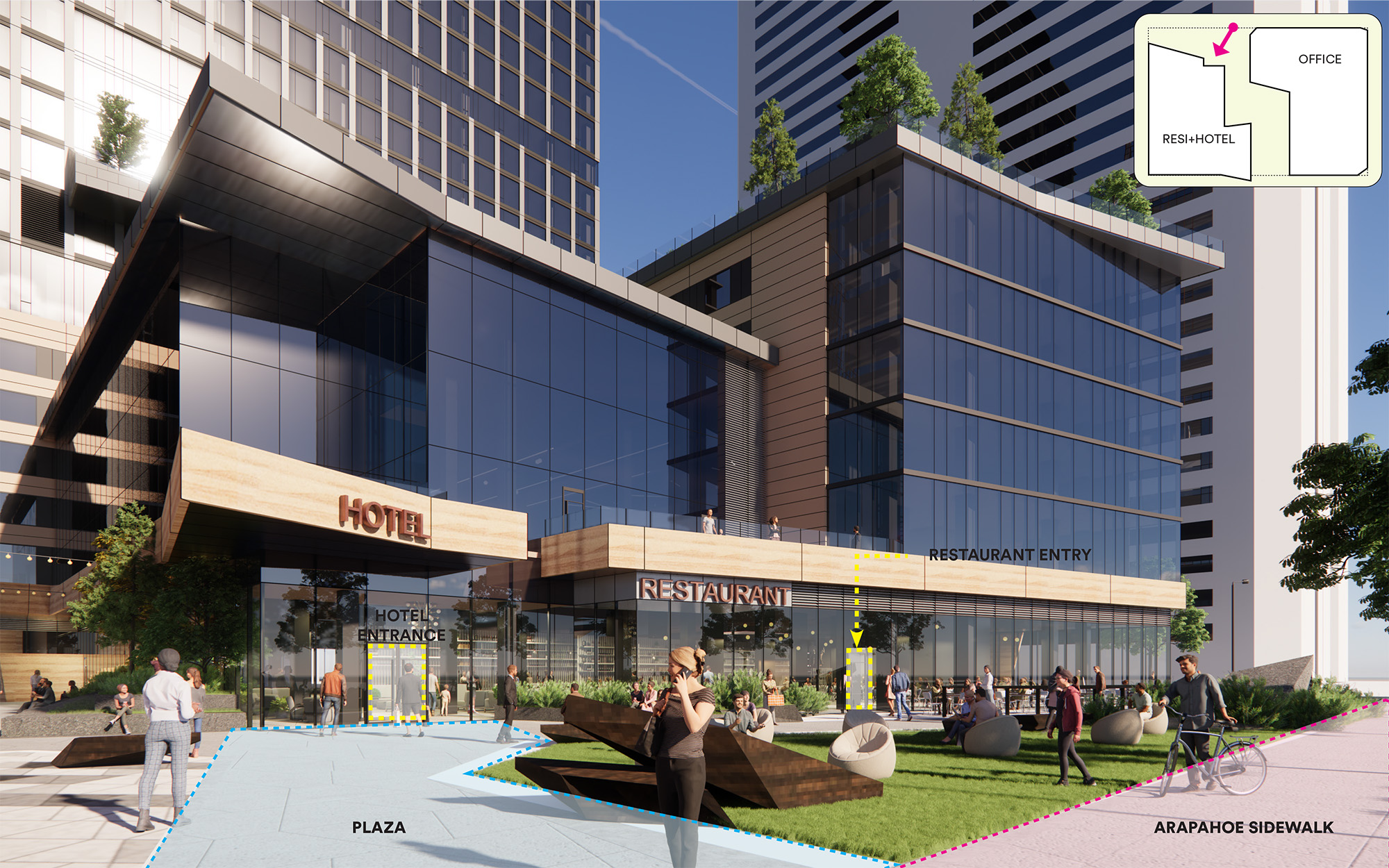








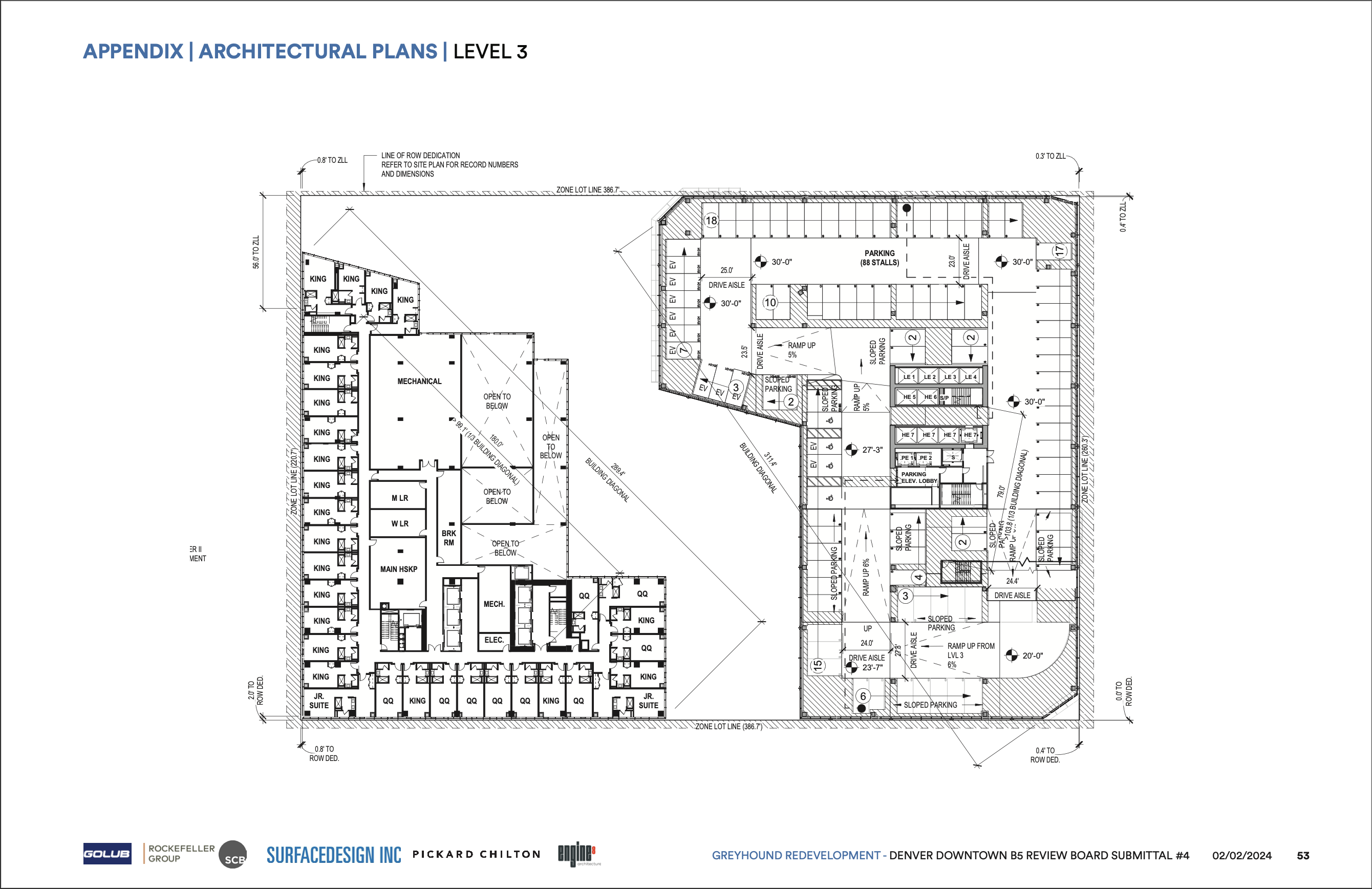











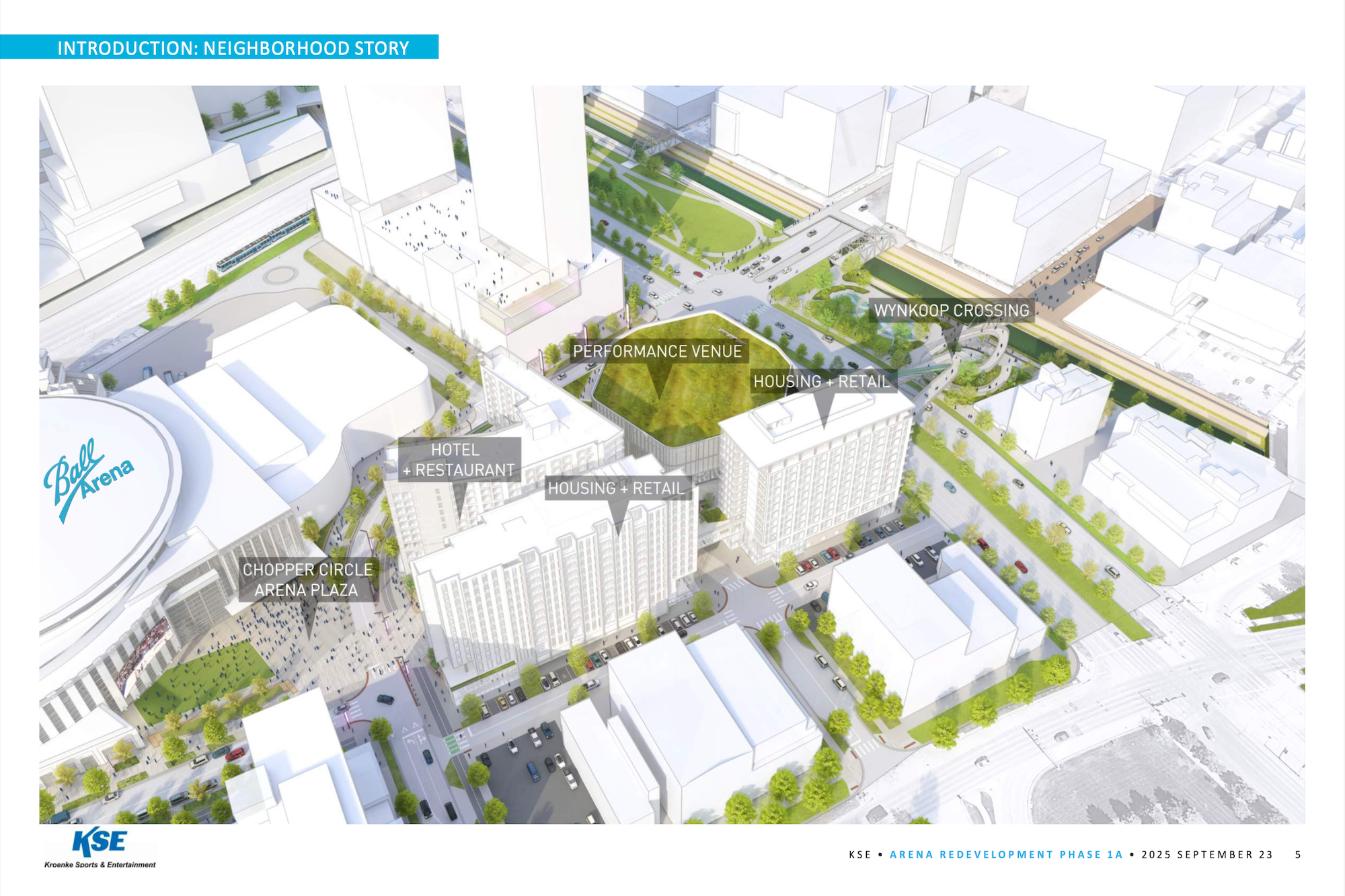
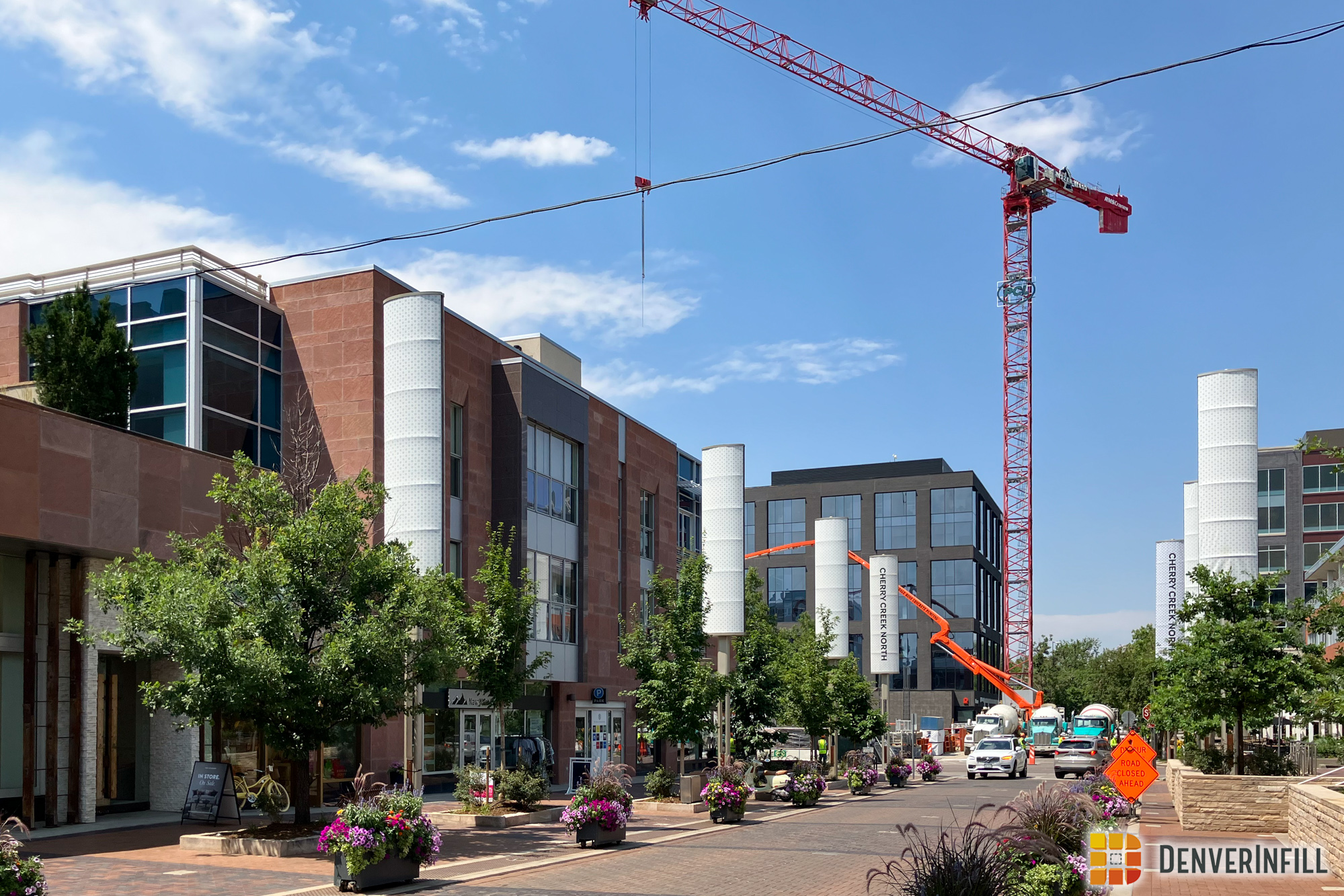
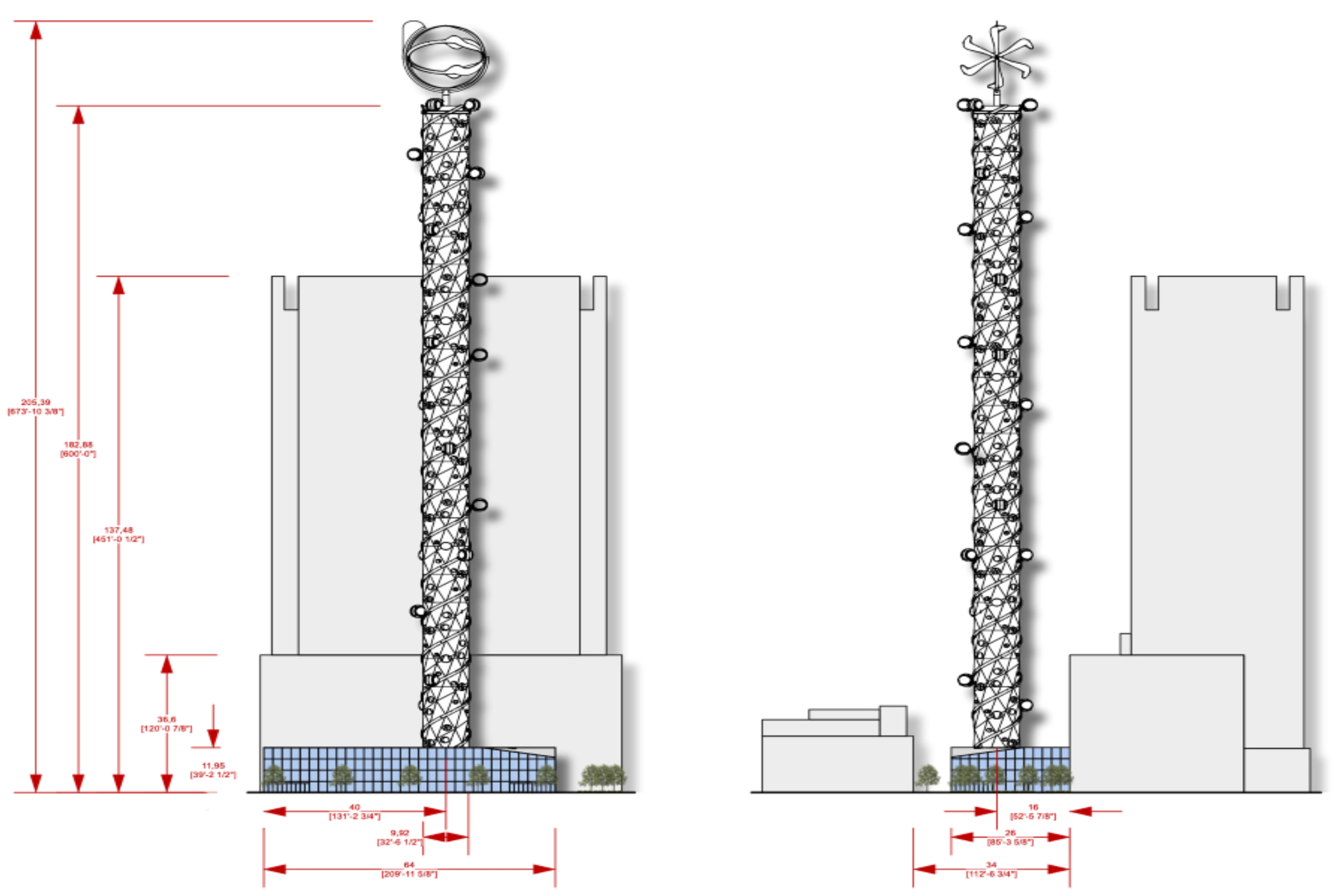




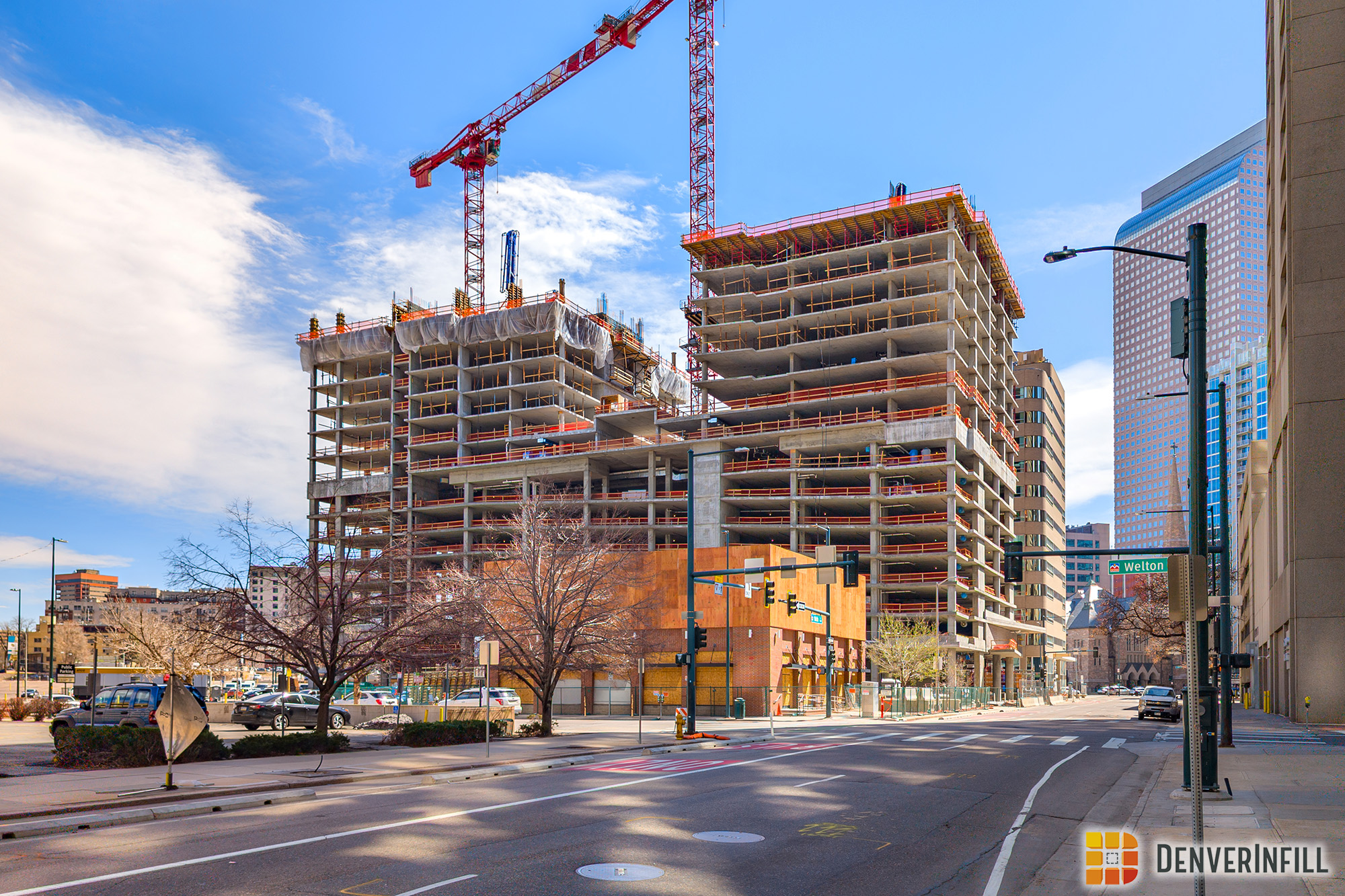

Seems like a nice development. However, I don’t understand why developers are still building office towers. I thought we had a glut (30% vacancy) of office space downtown. If I were the one controlling the money and resources, I would opt for two residential towers as we are dealing with one of the most severe housing shortages in city history.
Because Class A office space have a far, far lower vacancy rate then B and C space which seems to be practically abandoned and are dead as viable properties. Flight to quality for office remains a driving factor for commerical development.
Since the City still isn’t advocating for an all of the above approach to tackling housing and lowering the cost of entry for both commercial and public housing development I’ll presume that developers do want to hedge their bets with building programing so as to make projects viable for financing and possible divesture down the road.
The vacant Class B and C office buildings should be converted to residential, wherever possible.
Only four (4) of 16 vacant office buildings can be converted…and none are financially feasible to do so.
truly impressive. looking forward to this one!
The vacant Class B and C office buildings should be converted to residential, wherever possible.
Wow! Really excited for this one. Great write-up!
One reason why there are so many office vacancies downtown is the lack of modern amenities in those older office buildings. People would rather work at home than in a old, outdated office, but these new office buildings will attract workers and businesses again.
This looks great, but as John noted, the downtown office market is in sorry shape. Still, I’d love to see this constructed.
This development looks nice, but it doesn’t seem like architects are doing anything to reduce the massive number of fatal bird strikes when they continue to build these almost all glass towers.
Seven levels of above ground parking? Shameful! Put all parking below ground like a real city!
Parking below ground is hard to do in denver/colorado due to near immediate contact with rock. Although possible, I’m told the cost isn’t close to making sense in the Denver market. We aren’t that short on space contrary to what people preach.
^^^^This. Amen.
Actually, I don’t mind parking podiums because they automatically make the buildings 5-7 stories taller. Also, it saves the fossil fuels that would be used to excavate that deep and to haul off all the excess soil, which has to go somewhere. Yes, most projects seem to still have excess parking, though.
Who “preaches” that Denver is “short on space”? I haven’t heard anybody say that. I have heard that many people prefer cities with DENSITY instead of the sprawling car culture that is intentionally embraced in cities like Colorado Springs.
-Th
Really hope this comes to fruition so the destruction of Union Station (due to Greyhound riff raff) wasn’t all for naught.
To correlate undesired behavior at Union Station with Greyhound moving all operations to the Union Station Bus facility is elitist, uninformed, and ignorant. To say that those who ride Greyhound destroy the public place they are in the most dehumanizing characterization. The problems at Union Station are rooted in systemic affects of capitalism and the absence of robust social services, coupled with the fact that Union Station is the largest public space in the city, with free restrooms, shelter, and charging stations. Of course those who don’t have those things would flock their. Greyhound has had a presence at Union Station Bus Terminal since it opened. The riff raff you refer to is absolutely not because passengers of Greyhound now exclusively use the bus terminal.
The problems at Union Station are due to drug addicts and drug dealers using the bathrooms to use drugs. The situation has drastically improved since only ticketed bus riders can access the bus station. Also, there is now a greater police presence. Actual Greyhound riders just pass through the station.
I have some concerns of the shading in the covered areas causing ice problems in winter weather.
As to comments regarding converting the B & C office buildings to residential, that would be extremely capital expensive.
I would advocate for conversions if the buildings were purchased at a discount from the owners, and the housing authority converted the buildings to coop housing that the owners bought at a discount. This incentivizes stability and improves the ability of former renters to accumulate some wealth in the value of their housing.
Mediocre and overworked IMPO.
What’s the point of incorporating open space or a plaza if there isn’t a strong hyper-local commercial component to help activate (no, a hotel or office space does not count)?
This design further reinforces the notion that semi-private space is somehow a gracious contribution to the urban fabric (which it’s not and never has been). This “canyon” concept is dated, flawed, and a strong disservice to the surrounding street experience.
Nice addition, all nice, no guts, no glory, remember? Denver is in a settle for stage that’s all I got to say about that and better days may come. Anyhow I’m one of those archiveloper nerds that love to see change and particularly with this earthy earth tone stuff…is downtown style and development trying so hard not to compete with the rugged rocky mountains all the time that everything has to be brown and variant shades of mud and rock? What about the green pine? I’d be more amused if the color of this building was some shade(s) of green.